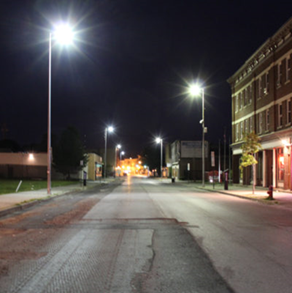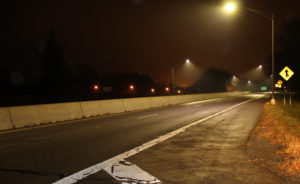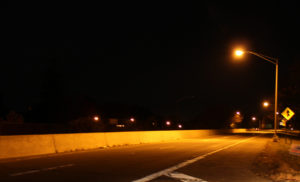Correlated Color Temperature (CCT) is the description of a light’s color in terms of its warmth or coolness. Represented by Kelvin, a CCT of below 3,000K will have a warm white appearance similar to that of an incandescent. As this value increases the light will become brighter and cooler. There is an ongoing discussion in the street lighting community concerning what an appropriate CCT is for street lighting, as LED’s with various options for CCT and Color Rendering Indexes (CRI) have come into the picture. There are many factors that come into play in this discussion and affect what CCT is chosen for a particular street lighting project.
to that of an incandescent. As this value increases the light will become brighter and cooler. There is an ongoing discussion in the street lighting community concerning what an appropriate CCT is for street lighting, as LED’s with various options for CCT and Color Rendering Indexes (CRI) have come into the picture. There are many factors that come into play in this discussion and affect what CCT is chosen for a particular street lighting project.
Safety
The international Dark-Sky Association (IDA), an organization focused on the control of light pollution, published a paper outlining the potential hazards of blue-rich white light sources. These blue-rich lights represent LEDs with high CCTs. The study found that increased blue light emissions increased the likelihood of glare and interference of the ability of the eye to adapt to low light levels. These emissions have also been known to interfere with the human endocrine system, leading to a reduction in the production of melatonin, a hormone shown to suppress breast cancer growth and development. IDA sought to avoid these effects by creating an FSA (Fixture Seal of Approval) requiring lighting with a CCT of 3,000K or lower.
Poor lighting caused by low CCT can also make it difficult for motorists to see hazards or objects clearly at night, creating an unsafe driving environment. Utilizing LED luminaires with higher color temperatures, such as 4000K, improves safety conditions when properly designed for the application. The higher or whiter the color temperature, the greater the perception of brightness is to the human eye. This allows for an increased ability to perceive colors, definition, and movement of other drivers, pedestrians, and objects all in a comparatively low light setting. It has also been shown that white light doubles a driver’s peripheral vision and reduces their braking times by 25% when compared to high pressure sodium lights (HPS) which have a low CCT. Locations that could benefit from this approach include areas where security is a concern, or high pedestrian conflict areas, such as intersections and downtown districts with a lot of nightlife.
Circadian Rhythm
Circadian rhythm is the internal clock that controls your sleep/wake cycle. It’s what causes you to feel tired at night and alert during the day. Outside factors such as light and darkness impact this cycle, which is why we get more tired as it gets darker and vice versa. When LED’s emerged as a viable and efficient light source, concerns arose that the white lights would cause circadian and sleep disturbances. Philips lighting, a global leader in LED lighting solutions, have stated that if properly designed and applied, there should be no impact on sleep behavior. This proper application and design involves choosing the right optics and light intensity for the area of application, specifically CCT.
Cost
In the first few years of LED outdoor lighting use, lights with higher CCTs were more available, efficient, and cheaper than those of lower CCTs. Efficiency losses occurred when creating warmer CCTs and thus production of these warmer lights was low. With advances in LED technology, warmer CCTs could be made without losing as much efficiency. Even with these advances, however, a higher-CCT LED is more efficacious than that of a lower CCT, keeping all other properties equal. This efficiency translates to lower utility costs and greater environmental benefits.
Appearance
Choosing the right CCT can affect not only the safety of an area, but the aesthetic appearance as well. Street lights with too low of a CCT will appear orange in color and cause a scene to look dreary or dark. Studies have consistently shown that this orange light makes streets look darker than a white-lit street, even with identical levels of luminance. Below is the difference between a street with lights of low CCT’s compared to the same street after having the lights replaced with LED’s with higher CCT’s.


Save 60-75% on Street Lighting Guaranteed With Wendel Energy Services
Installing lower wattage and longer lasting LED street lights reduces energy and maintenance costs by 60-75%. Wendel’s professional, in-house staff will perform a no cost/no pressure Preliminary Assessment of the potential for savings with your community’s street lighting. These same professionals can then design and implement a street lighting upgrade with 100% cost transparency.
